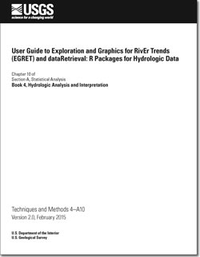User guide to Exploration and Graphics for RivEr Trends (EGRET) and dataRetrieval: R packages for hydrologic data
Links
- More information: USGS Index Page
- Document: Report (6.27 MB pdf)
- Appendixes:
- Data Release: USGS data release - dataRetrieval
- Download citation as: RIS | Dublin Core
Abstract
Evaluating long-term changes in river conditions (water quality and discharge) is an important use of hydrologic data. To carry out such evaluations, the hydrologist needs tools to facilitate several key steps in the process: acquiring the data records from a variety of sources, structuring it in ways that facilitate the analysis, processing the data with routines that extract information about changes that may be happening, and displaying findings with graphical techniques. A pair of tightly linked R packages, called dataRetrieval and EGRET (Exploration and Graphics for RivEr Trends), have been developed for carrying out each of these steps in an integrated manner. They are designed to easily accept data from three sources: U.S. Geological Survey hydrologic data, U.S. Environmental Protection Agency (EPA) STORET data, and user-supplied flat files. The dataRetrieval package not only serves as a “front end” to the EGRET package, it can also be used to easily download many types of hydrologic data and organize it in ways that facilitate many other hydrologic applications. The EGRET package has components oriented towards the description of long-term changes in streamflow statistics (high flow, average flow, and low flow) as well as changes in water quality. For the water-quality analysis, it uses Weighted Regressions on Time, Discharge and Season (WRTDS) to describe long-term trends in both concentration and flux. EGRET also creates a wide range of graphical presentations of the water-quality data and of the WRTDS results. This report serves as a user guide to these two R packages, providing detailed guidance on installation and use of the software, documentation of the analysis methods used, as well as guidance on some of the kinds of questions and approaches that the software can facilitate.
| Publication type | Report |
|---|---|
| Publication Subtype | USGS Numbered Series |
| Title | User guide to Exploration and Graphics for RivEr Trends (EGRET) and dataRetrieval: R packages for hydrologic data |
| Series title | Techniques and Methods |
| Series number | 4-A10 |
| DOI | 10.3133/tm4A10 |
| Edition | Version 1.0: Originally posted October 8, 2014; Version 2.0: February 5, 2015 |
| Year Published | 2015 |
| Language | English |
| Publisher | U.S. Geological Survey |
| Publisher location | Reston, VA |
| Contributing office(s) | National Research Program - Eastern Branch |
| Description | Report: vii, 93 p.; 2 Appendixes |
| Larger Work Type | Report |
| Larger Work Subtype | USGS Numbered Series |
| Larger Work Title | Section A: Statistical analysis in Book 4 Hydrologic Analysis and Interpretation |
| Public Comments | This report is Chapter 10 of Section A: Statistical analysis in Book 4 Hydrologic Analysis and Interpretation. |
| Online Only (Y/N) | Y |
| Additional Online Files (Y/N) | Y |


